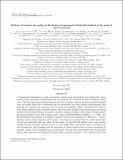Por favor, use este identificador para citar o enlazar a este item:
http://hdl.handle.net/10261/236841COMPARTIR / EXPORTAR:
 SHARE SHARE
 CORE
BASE CORE
BASE
|
|
| Visualizar otros formatos: MARC | Dublin Core | RDF | ORE | MODS | METS | DIDL | DATACITE | |

| Campo DC | Valor | Lengua/Idioma |
|---|---|---|
| dc.contributor.author | Hlavacek-Larrondo, Julie | es_ES |
| dc.contributor.author | Rhea, C. L. | es_ES |
| dc.contributor.author | Webb, T. | es_ES |
| dc.contributor.author | McDonald, M. | es_ES |
| dc.contributor.author | Muzzin, A. | es_ES |
| dc.contributor.author | Wilson, G. | es_ES |
| dc.contributor.author | Finner, K. | es_ES |
| dc.contributor.author | Valin, F. | es_ES |
| dc.contributor.author | Bonaventura, N. | es_ES |
| dc.contributor.author | Cooper, M. | es_ES |
| dc.contributor.author | Fabian, Andrew C. | es_ES |
| dc.contributor.author | Gendron-Marsolais, Marie-Lou | es_ES |
| dc.contributor.author | Jee, M.J. | es_ES |
| dc.contributor.author | Lidman, C. | es_ES |
| dc.contributor.author | Mezcua, Mar | es_ES |
| dc.contributor.author | Noble, A. | es_ES |
| dc.contributor.author | Russell, H. R. | es_ES |
| dc.contributor.author | Surace, Jason | es_ES |
| dc.contributor.author | Trudeau, A. | es_ES |
| dc.contributor.author | Yee, H. K. C. | es_ES |
| dc.date.accessioned | 2021-04-06T10:16:33Z | - |
| dc.date.available | 2021-04-06T10:16:33Z | - |
| dc.date.issued | 2020 | - |
| dc.identifier.citation | Astrophysical Journal Letters 898(2): L50 (2020) | es_ES |
| dc.identifier.uri | http://hdl.handle.net/10261/236841 | - |
| dc.description | arXiv:2007.15660v1 | es_ES |
| dc.description.abstract | Cosmological simulations, as well as mounting evidence from observations, have shown that supermassive black holes play a fundamental role in regulating the formation of stars throughout cosmic time. This has been clearly demonstrated in the case of galaxy clusters in which powerful feedback from the central black hole is preventing the hot intracluster gas from cooling catastrophically, thus reducing the expected star formation rates by orders of magnitude. These conclusions, however, have been almost entirely based on nearby clusters. Based on new Chandra X-ray observations, we present the first observational evidence for massive, runaway cooling occurring in the absence of supermassive black hole feedback in the high-redshift galaxy cluster SpARCS104922.6 + 564032.5 (z = 1.709). The hot intracluster gas appears to be fueling a massive burst of star formation (≈900 M⊙ yr−1) that is offset by dozens of kpc from the central galaxy. The burst is co-spatial with the coolest intracluster gas but not associated with any galaxy in the cluster. In less than 100 million years, such runaway cooling can form the same amount of stars as in the Milky Way. Therefore, intracluster stars are not only produced by tidal stripping and the disruption of cluster galaxies, but can also be produced by runaway cooling of hot intracluster gas at early times. Overall, these observations show the dramatic impact when supermassive black hole feedback fails to operate in clusters. They indicate that in the highest overdensities, such as clusters and protoclusters, runaway cooling may be a new and important mechanism for fueling massive bursts of star formation in the early universe. | es_ES |
| dc.description.sponsorship | J.H.-L. acknowledges support from NSERC via the Discovery grant program, as well as the Canada Research Chair program. C.R. acknowledges financial support from the physics department of the Université de Montréal. G.W. acknowledges support from the National Science Foundation through grant AST-1517863, by HST program number GO15294, and by grant number 80NSSC17K0019 issued through the NASA Astrophysics Data Analysis Program (ADAP). Support for program number GO-15294 was provided by NASA through a grant from the Space Telescope Science Institute, which is operated by the Association of Universities for Research in Astronomy, Incorporated, under NASA contract NAS5-26555. M.J.J. acknowledges support for the current research from the National Research Foundation of Korea under the programs 2017R1A2B2004644 and 2020R1A4A2002885. H.R.R. acknowledges support from an STFC Ernest Rutherford Fellowship and an Anne McLaren Fellowship. | es_ES |
| dc.language.iso | eng | es_ES |
| dc.publisher | IOP Publishing | es_ES |
| dc.relation.isversionof | Preprint | es_ES |
| dc.rights | openAccess | es_ES |
| dc.title | Evidence of runaway gas cooling in the absence of supermassive black hole feedback at the epoch of cluster formation | es_ES |
| dc.type | artículo | es_ES |
| dc.identifier.doi | 10.3847/2041-8213/ab9ca5 | - |
| dc.description.peerreviewed | Peer reviewed | es_ES |
| dc.relation.publisherversion | https://doi.org/10.3847/2041-8213/ab9ca5 | es_ES |
| dc.identifier.e-issn | 2041-8213 | - |
| dc.contributor.funder | Natural Sciences and Engineering Research Council of Canada | es_ES |
| dc.contributor.funder | National Aeronautics and Space Administration (US) | es_ES |
| dc.relation.csic | Sí | es_ES |
| oprm.item.hasRevision | no ko 0 false | * |
| dc.identifier.funder | http://dx.doi.org/10.13039/100000104 | es_ES |
| dc.identifier.funder | http://dx.doi.org/10.13039/501100000038 | es_ES |
| dc.type.coar | http://purl.org/coar/resource_type/c_6501 | es_ES |
| item.cerifentitytype | Publications | - |
| item.openairecristype | http://purl.org/coar/resource_type/c_18cf | - |
| item.grantfulltext | open | - |
| item.openairetype | artículo | - |
| item.fulltext | With Fulltext | - |
| item.languageiso639-1 | en | - |
| Aparece en las colecciones: | (ICE) Artículos | |
Ficheros en este ítem:
| Fichero | Descripción | Tamaño | Formato | |
|---|---|---|---|---|
| evideforma.pdf | 1,17 MB | Adobe PDF |  Visualizar/Abrir |
CORE Recommender
SCOPUSTM
Citations
12
checked on 29-abr-2024
WEB OF SCIENCETM
Citations
9
checked on 23-feb-2024
Page view(s)
68
checked on 04-may-2024
Download(s)
70
checked on 04-may-2024
Google ScholarTM
Check
Altmetric
Altmetric
NOTA: Los ítems de Digital.CSIC están protegidos por copyright, con todos los derechos reservados, a menos que se indique lo contrario.
